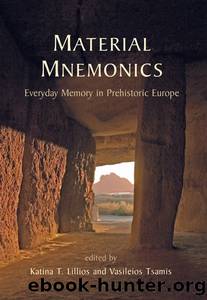Material Mnemonics by Unknown

Author:Unknown
Language: eng
Format: epub
Tags: SOCIAL SCIENCE / Archaeology
ISBN: XXXXXXXXXXXXX
Publisher: Casemate Publishers & Book Distributors, LLC
Published: 2010-09-12T00:00:00+00:00
6
Layers of memory: An embodied approach to Late Bronze Age Central Macedonia, Greece
Vasileios Tsamis
Recent studies in archaeology and memory (e.g. Van Dyke and Alcock 2003; Williams 2003) have demonstrated the role of remembering and forgetting in the past. Nevertheless, the majority of this work focuses on burial practices, monuments and artefact biographies. Little is said about everyday practices and the role of built space. In contrast, this chapter will focus on the embodiment of space and the role of body senses in triggering memories. Everyday practices are analysed in order to understand their role in the creation of locality and remembering (or forgetting).
Late Bronze Age Central Macedonia, Greece, will provide two case studies (Assiros and Kastanas) (Figure 6.1) in order to demonstrate the role of built space in the creation of memories. Mound settlements are the norm in Central Macedonia. Their long habitation period (more than 1000 years of continuous habitation) and their successive building phases can be interpreted as âlayers of memoryâ.
This approach will put forward an alternative way of interpreting built space in Prehistoric Macedonia. Moreover, it will introduce the importance of the mundane and locality in the process of remembering and forgetting in the past.
Introduction: memory and bodily experiences
This paper focuses on the role of memory in interpreting spatial organisation and introduces the notions âdurationâ and âmulti-temporalityâ, both closely related with memory in Bergsonâs book Matter and Memory (Bergson 1991[1908]). With the term duration I want to illustrate the enduring bodily experiences of space and material culture. The term multi-temporality refers to experiences and practices that have been lost or forgotten at an early stage of habitation only to be rediscovered several decades later. Embodied space is defined as the process of potential bodily experiences within place and across time. Moreover, the idea of âlayers of memoryâ does not refer to bounded building phases that trigger remembering, but indicates the endurance and negotiation of bodily experiences through remembering and forgetting.
Download
This site does not store any files on its server. We only index and link to content provided by other sites. Please contact the content providers to delete copyright contents if any and email us, we'll remove relevant links or contents immediately.
Cecilia; Or, Memoirs of an Heiress — Volume 1 by Fanny Burney(32434)
Cecilia; Or, Memoirs of an Heiress — Volume 2 by Fanny Burney(31871)
Cecilia; Or, Memoirs of an Heiress — Volume 3 by Fanny Burney(31854)
The Lost Art of Listening by Michael P. Nichols(7406)
Asking the Right Questions: A Guide to Critical Thinking by M. Neil Browne & Stuart M. Keeley(5635)
We Need to Talk by Celeste Headlee(5542)
On Writing A Memoir of the Craft by Stephen King(4863)
Dialogue by Robert McKee(4321)
Pre-Suasion: A Revolutionary Way to Influence and Persuade by Robert Cialdini(4148)
I Have Something to Say: Mastering the Art of Public Speaking in an Age of Disconnection by John Bowe(3840)
Elements of Style 2017 by Richard De A'Morelli(3307)
The Book of Human Emotions by Tiffany Watt Smith(3238)
Fluent Forever: How to Learn Any Language Fast and Never Forget It by Gabriel Wyner(3028)
Name Book, The: Over 10,000 Names--Their Meanings, Origins, and Spiritual Significance by Astoria Dorothy(2939)
Good Humor, Bad Taste: A Sociology of the Joke by Kuipers Giselinde(2903)
Why I Write by George Orwell(2874)
The Art Of Deception by Kevin Mitnick(2736)
The Grammaring Guide to English Grammar with Exercises by Péter Simon(2710)
Ancient Worlds by Michael Scott(2625)
